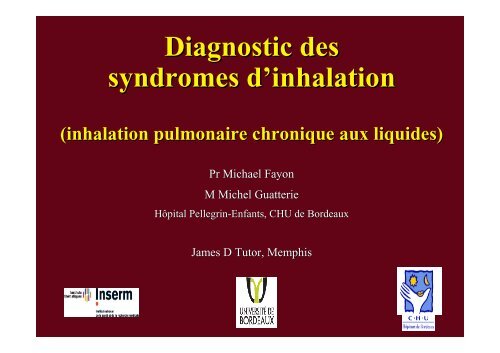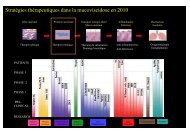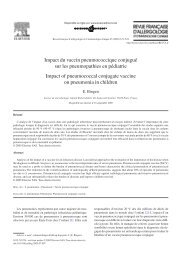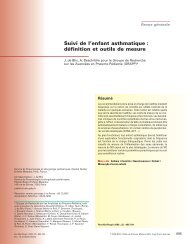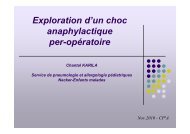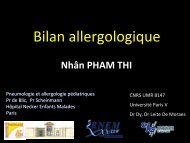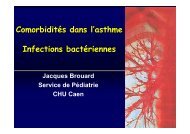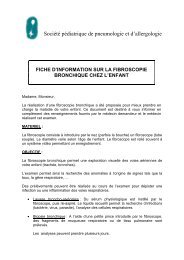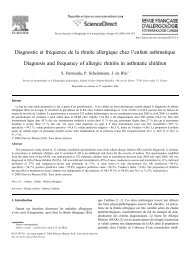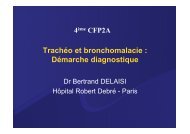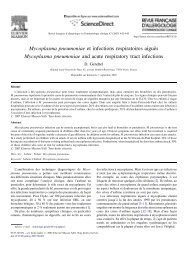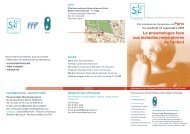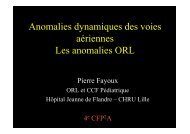Diagnostic des pathologies d'inhalation - Société pédiatrique de ...
Diagnostic des pathologies d'inhalation - Société pédiatrique de ...
Diagnostic des pathologies d'inhalation - Société pédiatrique de ...
You also want an ePaper? Increase the reach of your titles
YUMPU automatically turns print PDFs into web optimized ePapers that Google loves.
<strong>Diagnostic</strong> <strong><strong>de</strong>s</strong><br />
syndromes d’inhalationd<br />
(inhalation pulmonaire chronique aux liqui<strong><strong>de</strong>s</strong>)<br />
Pr Michael Fayon<br />
M Michel Guatterie<br />
Hôpital Pellegrin-Enfants, CHU <strong>de</strong> Bor<strong>de</strong>aux<br />
James D Tutor, , Memphis
Inhalation<br />
chronique<br />
3 mécanismesm<br />
Troubles <strong>de</strong> la déglutition<br />
RGO<br />
Fonctionnels<br />
Anomalies anatomiques<br />
Inhalation salivaire<br />
• + hypersialorrhée
Examen clinique<br />
Moyens diagnostiques<br />
RP – TDM thoracique<br />
Radiocinéma<br />
<strong>de</strong> déglutitiond<br />
Fibroscopie<br />
Fibroscopie bronchique / LBA/lipophages<br />
Nasofibroscopie (<strong>de</strong> déglutition)<br />
TOGD / pHmétrie<br />
/ Manométrie<br />
Scintigraphie salivaire (Salivogramme(<br />
Salivogramme)<br />
Sonographie<br />
Test au bleu
Examen clinique<br />
Moyens diagnostiques<br />
RP – TDM thoracique<br />
Radiocinéma<br />
<strong>de</strong> déglutitiond<br />
Fibroscopie<br />
Fibroscopie bronchique / LBA/ lipophages<br />
Nasofibroscopie (<strong>de</strong> déglutition)<br />
TOGD / pHmétrie<br />
/ Manométrie<br />
Scintigraphie salivaire (Salivogramme(<br />
Salivogramme)<br />
Sonographie<br />
Test au bleu
Présentation clinique<br />
Suffocation lors <strong><strong>de</strong>s</strong> têtées<br />
succion lente, remplissage passif <strong>de</strong> la bouche, reflux <strong>de</strong> lait au niveau du<br />
nez<br />
Signes trompeurs / Symptômes respiratoires « inexpliqués »<br />
Toux, wheezing, « asthme », retard <strong>de</strong> croissance, pneumopathie à<br />
répétition (zones déclives), épaississement bronchique, distension,<br />
syndrome interstitiel, malaises, hémoptysies (+ IPLV : Syndrome <strong>de</strong><br />
Heiner)<br />
Contexte<br />
préma, anoxie NN, retard psychomoteur, hypotonie, enfant « normal »
ATCDS<br />
Evaluation clinique<br />
Médicaux, développement, alimentaires et diététiques<br />
Observation du patient +++<br />
Clinique vs. Radiocinéma<br />
<strong>de</strong> déglutition d<br />
(Dematteo<br />
2005)<br />
Sn 92 %<br />
Sp 33 %<br />
VPP 54 %<br />
VPN 89 %<br />
• Inhalation « silencieuse »<br />
Toux, Liqui<strong><strong>de</strong>s</strong> > Soli<strong><strong>de</strong>s</strong>
SC prédictifs d’une d<br />
Radiocinéma<br />
pathologique<br />
150 enfants, M : 59.3% - F : 40.7%)<br />
Age médian 16 mois (moyenne 37; 2 sem –247 mois).<br />
Toux<br />
Voix « humi<strong>de</strong> »<br />
Respiration « humi<strong>de</strong> »<br />
Weir 2009
Non spécifique<br />
Imagerie
Lobes Inférieurs<br />
Segments basals et postérieurs<br />
Lobes Supérieurs<br />
Segments postérieurs<br />
DDB, Hyperinflation, Atélectasie
Radiocinéma<br />
<strong>de</strong> déglutitiond<br />
Principe<br />
Visualise<br />
Matériel utiliséé<br />
Image radiographique <strong>de</strong> la cavité<br />
orale → l’oesophage<br />
Pendant les 4 phases <strong>de</strong> la déglutition<br />
En temps réel<br />
Petite qté d’hydrosolubles<br />
liqui<strong>de</strong>, semi-soli<strong>de</strong> ou soli<strong>de</strong><br />
(couche <strong>de</strong> produit <strong>de</strong> contraste)<br />
Durée<br />
2-4 minutes<br />
Ex prolongé parfois nécessaire n<br />
:<br />
fatigue en fin d ’examen
Les 4 phases <strong>de</strong> la déglutitiond<br />
Hammond 2008
Déglutition<br />
normale - enfant
Inhalation importante (adulte)
Inhalation modérée e (adulte)
Inhalation discrète<br />
- Toux à l’ingestion (enfant)
Aucune fausse route mais<br />
œdème du SSO trahissant un RGO chronique
Renseignements obtenus<br />
Vidange prématur<br />
maturée e avant la déglutitiond<br />
Rétard<br />
<strong>de</strong> déglutitiond<br />
Inhalation (pénétration laryngée e avec ou sans toux)<br />
Reflux naso-pharyng<br />
pharyngé<br />
Résidus pharyngés s après s la déglutitiond<br />
Difficulté <strong>de</strong> passage a/n oesophagien<br />
RGO<br />
La meilleure consistance <strong>de</strong> l’alimentation<br />
l
Validité interne<br />
PAS d’ETUDES d<br />
PEDIATRIQUES<br />
Technique<br />
Technique <strong>de</strong><br />
comparaison<br />
Sensibilité<br />
Spécificité<br />
Radiocinéma<br />
<strong>de</strong> déglutition<br />
Nasofibroscopie<br />
<strong>de</strong> déglutition<br />
100 %<br />
(adultes)<br />
63 %<br />
(adultes)
Recherche <strong>de</strong> RGO<br />
Performance en pédiatrie p<br />
?<br />
pHmétrie<br />
Mvse corrélation entre RGO et Inhalation<br />
Multicanaux (?)<br />
Impé<strong>de</strong>ncem<br />
<strong>de</strong>ncemétrie, , Manométrie<br />
Détecte les RGO proximaux et non-aci<strong><strong>de</strong>s</strong><br />
Difficile à interpréter<br />
TOGD<br />
Faible Sn<br />
Informations anatomiques et sur la motricité oes.
Achalasie oesophagienne
Inhalation<br />
chronique<br />
(rat)<br />
SP<br />
Liqui<strong>de</strong> gastrique<br />
SP<br />
Liqui<strong>de</strong> gastrique neutralisé<br />
Downing 2008
Inhalation<br />
chronique<br />
(rat)<br />
HCl<br />
HCl<br />
Bile<br />
Bile<br />
Suspension d’aliments<br />
Downing 2008
Endoscopie<br />
Nasofibroscopie <strong>de</strong> déglutitiond<br />
(FEES : Fiberoptic Endoscopic Evaluation of Swallowing)<br />
Visualisation directe <strong>de</strong> la déglutition d<br />
Sans sédation<br />
Aliment traceur coloré
Fibroscopie <strong>de</strong> déglutitiond<br />
P Fayoux, Lille
Fibroscopie <strong>de</strong> déglutitiond<br />
Modalités s d’examen: d<br />
position habituelle <strong>de</strong> repas (assis sur genoux ou en<br />
corset siège)<br />
pas d’anesthésie locale pour pouvoir tester la<br />
sensibilité pharyngo-laryngé => utilisation d’un<br />
fibroscope <strong>de</strong> 2.2 mm et lubrification +++ pour<br />
améliorer la tolérance<br />
Permet l’évaluation anatomique: recherche d’une<br />
malformation pharyngolaryngée<br />
P Fayoux, Lille
Étu<strong>de</strong> anatomique et fonctionnelle:<br />
Signes extra-digestifs <strong>de</strong> RGO<br />
Mobilité pharyngo-laryngée<br />
Test la sensibilité : reflexe adducteur laryngé<br />
• stimulation <strong>de</strong> la margelle<br />
• air pulsé : aN si pas <strong>de</strong> reflexe > 4 mmHg<br />
Coordination pharyngo-laryngée et pharyngooesophagienne<br />
en phase <strong>de</strong> déglutition<br />
Objective l’inhalation salivaire ou alimentaire<br />
P Fayoux, Lille
Inhalation +++ Adulte
Inhalation salivaire
Validité interne<br />
Technique<br />
Technique <strong>de</strong><br />
comparaison Sensibilité Spécificité<br />
Nasofibroscopie<br />
<strong>de</strong> déglutition<br />
Fiberoptic<br />
Endoscopic<br />
Evaluation of<br />
Swallowing<br />
(FEES)<br />
Radiocinéma<br />
<strong>de</strong> déglutition<br />
70 - 96%<br />
(adultes)<br />
87.5 - 100%<br />
(adultes)
Endoscopie<br />
Fibroscopie bronchique<br />
Anomalies anatomiques<br />
LBA<br />
• FOT (test au bleu)<br />
• « Lipid-la<strong>de</strong>n macrophages » (lipophages)
L Donato<br />
La Timone, Marseille
LBA - Lipophages
100 cellules = score max 400<br />
P Ahrens et al. 1999
Validité interne<br />
Technique<br />
Technique <strong>de</strong><br />
comparaison<br />
Sensibilité<br />
Spécificité<br />
In<strong>de</strong>x<br />
“lipophagique”<br />
Lipid La<strong>de</strong>n<br />
Macrophage<br />
In<strong>de</strong>x<br />
(LLMI)<br />
Un ensemble<br />
d’examens<br />
complémentaires<br />
et d’imagerie<br />
69 – 98.6%<br />
(Nourrissons<br />
et enfants)<br />
78 - 79%<br />
(Nourrissons<br />
et enfants)<br />
(Score <strong>de</strong> 0 – 400) Colombo<br />
Furuya<br />
Bauer<br />
Seuil > 86 > 165 > 90<br />
Sn % 98,6 69<br />
Sp % 78,0 79
Age 1 mois – 16 ans<br />
Patho pulmonaire + + -<br />
Suspicion d’inhalation + - -<br />
Fuyura 2007
Age 1 mois – 16 ans<br />
Meilleur seuil >165<br />
Sn (%) 98.6<br />
Sp (%) 78.0<br />
VPP (%) 81.6<br />
VPN (%) 97.0<br />
Précision globale<br />
Accuracy (%) 87.8<br />
Fuyura 2007
Lipophages<br />
Faux POSITIFS :<br />
MCV<br />
Lipi<strong><strong>de</strong>s</strong> IV<br />
Embolie graisseuse (Drépanocytose)<br />
Pneumonie lipoï<strong>de</strong> (obstruction bronchique)<br />
Bronchiolite oblitérante<br />
Peu reproductible (Timing vs. épiso<strong>de</strong> d’inhalation)<br />
d<br />
A interpréter en fonction du contexte clinique et <strong><strong>de</strong>s</strong> autres<br />
examens
Salivogramme<br />
Scintigraphie salivaire<br />
Principe<br />
Dépôt d’un traceur radioactif dans la bouche<br />
Imagerie séquentielle jusqu’à la disparition du traceur <strong>de</strong><br />
la bouche
Inhalation salivaire<br />
Proximale<br />
Distale
Performance<br />
Chez les enfants suspects<br />
Prévalence : 26 – 73 % (3 étu<strong><strong>de</strong>s</strong> rétrospectives)<br />
Validité interne ?<br />
• Pas <strong>de</strong> tests <strong>de</strong> confirmation <strong><strong>de</strong>s</strong> FR salivaires<br />
Utile pour ajuster le Ventilation Artificielle chez les<br />
enfants trachéotomis<br />
otomisés s (Fin<strong>de</strong>r et al.)
Inhalation Pulmonaire<br />
Chronique ?<br />
Etu<strong>de</strong> <strong>de</strong> déglutitiond<br />
+<br />
-<br />
Traitement chirurgical<br />
Modif. . alimentation<br />
Eval. anat<br />
Mieux<br />
Pas<br />
Mieux<br />
Maladie Pulm ?<br />
-Fibro/LBA<br />
-Scan<br />
thor (?)<br />
TDM pathologique<br />
Llipophages<br />
TDM N<br />
Pas <strong>de</strong> lipophages<br />
Autre cause ?<br />
Poursuite<br />
Alimentation adaptée<br />
Recherche<br />
<strong>de</strong><br />
RGO<br />
Boesch 2006
Recherche<br />
-<br />
<strong>de</strong> RGO<br />
+<br />
Récidive<br />
symptômes<br />
Efficace<br />
Alim/Son<strong>de</strong> NG<br />
Cx antiRGO<br />
Gastrostomie<br />
Symptômes<br />
persistants<br />
Résolution <strong><strong>de</strong>s</strong><br />
Symptômes<br />
Symptômes<br />
persistants<br />
Cx séparation s<br />
L-TL<br />
Recherche Aspiration<br />
Salivaire<br />
+<br />
Cx glan<strong><strong>de</strong>s</strong> salivaires<br />
Injection toxine botulique<br />
-<br />
Résolution <strong><strong>de</strong>s</strong><br />
Symptômes<br />
Ré-évaluer<br />
Nissen<br />
Fibro ORL pdt déglutition ?<br />
Scan thoracique<br />
Suivi clinique régulierr
L’avenir ?
Conclusion<br />
Signes cliniques trompeurs<br />
Pas d’éd<br />
’étalon d’or d<br />
:<br />
Radiocinéma : spécifique<br />
Nasofibroscopie <strong>de</strong> déglutition : sensible<br />
Arbre décisionneld<br />
Equipes pluridisciplinaires (Dg et traitement)<br />
ORL – Radio – Gastro – Pneumo – Diet – Kiné – IDE –<br />
Psychologue – Orthophoniste – « SLT » (spécialistes<br />
oralité)
Références :<br />
Boesch RP et al. ERJ 2006<br />
<strong>de</strong> Benedictus FM et al. PCNA 2009<br />
Fayon M et al.<br />
Pneumologie Pédiatrique<br />
Flammarion 2010<br />
Tutor James et al. Pediatric Pulmonology Oct 2011
Dosage d’autres d<br />
marqueurs<br />
Pepsine ….<br />
Lactose …
v<br />
Prémas<br />
Age< 28 j<br />
VA<br />
N = 256 Asp trach<br />
Chez 59 NN<br />
Positivité = 91.4 %
Pepsin PedLung<br />
We have extensive experience with various assays for pepsin.<br />
There are activity assays and immunoassays… The immunoassays are not specific enough,<br />
and pretty much EVERYONE has a positive test…<br />
The activity assays are variable and can be non-specific as well, picking up cathepsin for<br />
example. But they CAN be very sensitive and specific, in fact we have one that we<br />
believe is exactly that. We use it for research purposes though.<br />
Pepsin can retain its activity in BAL for a week at room temperature.<br />
ture. Perhaps it can likewise<br />
retain its activity in the airway itself for a long time too?<br />
So, here is the other issue… If you have a high pepsin level in airway fluid, it means<br />
aspiration… with reasonable confi<strong>de</strong>nce. But pretty much everybody probably aspirates<br />
from time to time. Does a high level mean LOTS of aspiration, or just a recent<br />
aspiration? Does a low level mean tiny aspiration, or a MAJOR aspiration four r days<br />
ago? This is not known.<br />
Aspiration remains a mystery to a great extent… This is what I do: I test lipid la<strong>de</strong>ns and<br />
pepsin, use technetium scans and gut feelings, empirically treat, , struggle, guess, hope and<br />
pray… Stick all that together in a pile and practice the art of medicine.<br />
ine. No computer<br />
can pull this off. No government edict can pull this off. This is not something that can<br />
get measured by ACGME or JCAHO… It cannot be quantified by Quality Initiatives,<br />
nor assisted by so-poorly named “best practices”.<br />
That being said, a NEGATIVE pepsin test is a good sign of infrequency of aspiration. And<br />
POSITIVE technetium scan is a good sign of a well-timed aspiration event..Not sensitive,<br />
but darn specific..<br />
John Hunt, MD<br />
UVA
N = 51 enfants normaux a/n neuro<br />
(médiane 6,5 ans – 1 m à 11,5 a)<br />
Chest 2006
SC prédictifs d’une d<br />
Radiocinéma<br />
pathologique<br />
150 enfants, M : 59.3% - F : 40.7%)<br />
Age médian 16 mois (moyenne 37; 2 sem –247 mois).<br />
Toux<br />
Voix « humi<strong>de</strong> »<br />
Respiration « humi<strong>de</strong> »<br />
Inhalation oropharyngée<br />
Inhalation silencieuse<br />
Pénétration laryngée isolée<br />
Résidu post-déglutition<br />
Weir 2008


